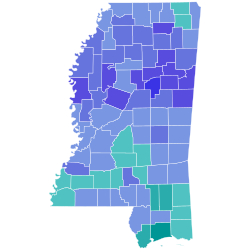| | |||||||||||||||||
| |||||||||||||||||
| |||||||||||||||||
 County results Coleman: 50-60% 60-70% 70-80% 80-90% Johnson: 50-60% 60-70% 70-80% | |||||||||||||||||
| |||||||||||||||||
| Elections in Mississippi |
|---|
 |
The 1955 Mississippi gubernatorial election took place on November 8, 1955, in order to elect the Governor of Mississippi. Incumbent Democrat Hugh L. White was term-limited, and could not run for reelection to a second term. As was common at the time, the Democratic candidate ran unopposed in the general election, so therefore the Democratic primary was the real contest, and winning the primary was considered tantamount to election. This election was the first Mississippi gubernatorial election since 1931 that the winner of the gubernatorial election was of a different party than the incumbent president.

